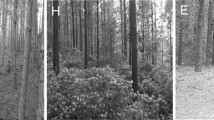Abstract
We estimated the densities of termites in dead wood using a point-quarter technique in four habitats: pine plantations subject to control burning and unburned, lowland hardwood forest, and turkey oak woodland. The burned pine plantation had the highest estimated termite density, 13×106·ha-1 unburned pine plantation and lowland hardwood had estimated densities of 2.6×106·ha-1 and 2.2×106·ha-1, respectively, and the turkey oak woodland had an estimated densities of 61.9×103·ha-1. There were varying percentages of Reticulitermes flavipes and R. virginicus in the various habitats. There was nearly linear increase in percentage of pine blocks attacked by termites in the pine and hardwood forests and by the end of the growing season, nearly all had been channelized by termites. In the turkey oak habitat 70% of the pine blocks were channelized. Termites removed between 3% and 12% of the original mass of over one-fourth of the pine blocks during the growing season.
Wood litter in fall was highest in the lowland hardwood forest: 2869 kg·ha-1·yr-1. Wood litter input in the long leaf pine plantation, 792 kg·ha-1·yr-1 was nearly equivalent to the three year average wood litter in fall in a Danish oak forest.
Similar content being viewed by others
References
Ausmus BS (1977) Regulation of wood decomposition rates by arthropod and annelid populations. Ecol Bull 25, 180–192
Christensen O (1978) The dynamics of wood litter fall in a Danish oak forest. Natural Jutlandlica 20, 155–162
Howard RW, Haverty MI (1980) Reproductives in mature colonies of Reticulitermes flavipes: Abundance, sex-ratio, and association with soldiers. Environ Entomol 9, 458–460
Kitchell JG, O'Neill RV, Webb D, Gallepp GW, Bartell SM, Koonce JF, Ausmus BS (1979) Consumer regulation of nutrient cycling. BioScience 29, 28–34
Lee KE, Butler JHA (1977) Termites, soil organic matter decomposition and nutrient cycling. Ecol Bull 25, 544–548
Lang GE, Foreman RT (1978) Detrital dynamics in a mature oak forest: Hutcheson Memorial Forest, New Jersey. Ecology 59, 580–595
Phillips EA (1959) Methods of vegetation study. Holt, Rhinehart, and Winston, Inc, New York, NY 107 pp
Wiegert RG (1970) Energetics of the nest building termite Nasutitermes costalis (Holm) in a Puerto Rican forest. In: A tropical rain forest. A study of irradiation and ecology at El Verde, Puerto Rico (HT Odum, ed), Vol 1, pp 57–64. Division of Technical Information, United States Atomic Energy Commission
Author information
Authors and Affiliations
Rights and permissions
About this article
Cite this article
Gentry, J.B., Whitford, W.G. The relationship between wood litter infall and relative abundance and feeding activity of subterranean termites Reticulitermes spp. in three southeastern coastal plain habitats. Oecologia 54, 63–67 (1982). https://doi.org/10.1007/BF00541109
Received:
Issue Date:
DOI: https://doi.org/10.1007/BF00541109




